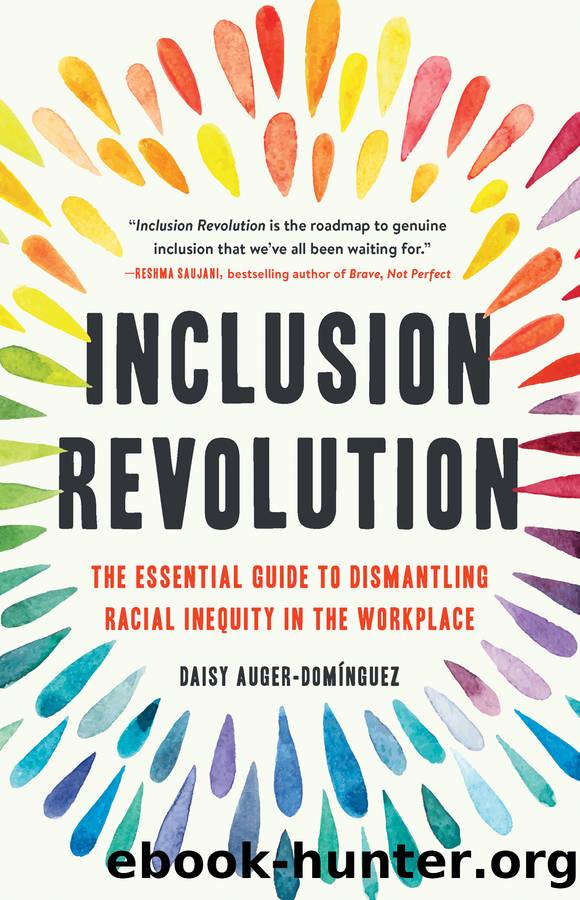Inclusion Revolution by Daisy Auger-Domínguez

Author:Daisy Auger-Domínguez [Auger-Domínguez, Daisy]
Language: eng
Format: epub
Publisher: Basic Books
Published: 2022-01-12T00:00:00+00:00
Be an Inclusion Truth Seeker
Ask questions before you provide answers. Listen to the lived experience of others and recognize the good, the bad, and the ugly about your workplace culture. A truth seeker has an open mind and doesnât neglect or overlook information because it goes against what they believe or want to be true. Make it your mission to seek feedback and perspectives on how employees of different races and identities experience work and how you and your organization can do better. That said, be careful that you donât force BIPOC to be problem-solvers when the responsibility for nurturing an inclusive workplace culture is yours.
Expect to get uncomfortable. I have yet to engage in a conversation about racial equity where the simple use of words like âracism,â âwhiteness,â and âprivilegeâ hasnât made people visibly uneasy. For there to be sustainable change, you will have to tolerate and push through discomfort and create opportunities for people to lean into these conversations. And you will have to make it clear that you will not brush past or ignore conflict.
Embarking on a listening journey is a great way to start. Iâve led many listening sessions. Most have been designed as conversations where leaders have met with members of different employee resource groups to hear their concerns. At Vice Media Group, CEO Nancy Dubuc and I embarked on a seven-week global listening series following allegations of negative experiences by Black and brown former employees at Refinery29. We took the stories of these women very seriously and sought to discover how diversity, equity, and inclusion were experienced across all teams.
To create brave spaces for conversation, we brought in a facilitator, a member of our internal communications team, to guide the discussion. In the welcoming remarks, the facilitator explained that Dubuc and I were there to listen and not respond until the end, when we would offer closing remarks. It was important to have an impartial colleague who the teams trusted to help facilitate the discussion. Alternatively, you can hire a third-party neutral facilitator. The sessions were done on a video chat (this was during the pandemic), were capped at twenty peopleâsmall enough to build trust and intimacy but large enough to offer diversity of opinionâand were explicitly framed to examine issues of inclusion, equity, and belonging across our teams. For those most afraid to speak up, we encouraged them to use our anonymous hotline to share their feedback.
At the beginning of each session, we asked participants to reflect on these questions:
⢠What are the conditions (policies, programs) that may sustain white, male, hetero, cis, and/or able-bodied power and presence within our teams and work?
⢠In which situations have you felt things to be unfair and unsafe?
The dialogue was further framed in a three-pronged approach, allocating equal time for each section:
1. Stop. What are some things we should stop doing that are deterring the growth and presence of coworkers from marginalized groups?
2. Start. What are some things we should start doing to better support the growth and presence of coworkers from marginalized groups?
3.
Download
This site does not store any files on its server. We only index and link to content provided by other sites. Please contact the content providers to delete copyright contents if any and email us, we'll remove relevant links or contents immediately.
Zero to IPO: Over $1 Trillion of Actionable Advice from the World's Most Successful Entrepreneurs by Frederic Kerrest(4073)
Machine Learning at Scale with H2O by Gregory Keys | David Whiting(3653)
Harry Potter and the Goblet Of Fire by J.K. Rowling(3614)
Never by Ken Follett(3543)
Ogilvy on Advertising by David Ogilvy(3347)
Shadow of Night by Deborah Harkness(3181)
The Man Who Died Twice by Richard Osman(2818)
Book of Life by Deborah Harkness(2725)
My Brilliant Friend by Elena Ferrante(2707)
How Proust Can Change Your Life by Alain De Botton(2619)
0041152001443424520 .pdf by Unknown(2605)
Will by Will Smith(2588)
The Tipping Point by Malcolm Gladwell(2565)
How to Pay Zero Taxes, 2018 by Jeff A. Schnepper(2505)
Purple Hibiscus by Chimamanda Ngozi Adichie(2501)
Hooked: A Dark, Contemporary Romance (Never After Series) by Emily McIntire(2428)
Rationality by Steven Pinker(2155)
Borders by unknow(2121)
Daughter of Smoke and Bone by Laini Taylor(2086)
